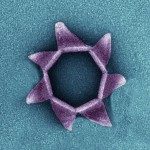Lien vers Pubmed [PMID] – 10795828
J. Mol. Evol. 2000 Apr;50(4):366-80
The phylogenetic placement of the Aquifex and Thermotoga lineages has been inferred from (i) the concatenated ribosomal proteins S10, L3, L4, L23, L2, S19, L22, and S3 encoded in the S10 operon (833 aa positions); (ii) the joint sequences of the elongation factors Tu(1alpha) and G(2) coded by the str operon tuf and fus genes (733 aa positions); and (iii) the joint RNA polymerase beta- and beta’-type subunits encoded in the rpoBC operon (1130 aa positions). Phylogenies of r-protein and EF sequences support with moderate (r-proteins) to high statistical confidence (EFs) the placement of the two hyperthermophiles at the base of the bacterial clade in agreement with phylogenies of rRNA sequences. In the more robust EF-based phylogenies, the branching of Aquifex and Thermotoga below the successive bacterial lineages is given at bootstrap proportions of 82% (maximum likelihood; ML) and 85% (maximum parsimony; MP), in contrast to the trees inferred from the separate EF-Tu(1alpha) and EF-G(2) data sets, which lack both resolution and statistical robustness. In the EF analysis MP outperforms ML in discriminating (at the 0.05 level) trees having A. pyrophilus and T. maritima as the most basal lineages from competing alternatives that have (i) mesophiles, or the Thermus genus, as the deepest bacterial radiation and (ii) a monophyletic A. pyrophilus-T. maritima cluster situated at the base of the bacterial clade. RNAP-based phylogenies are equivocal with respect to the Aquifex and Thermotoga placements. The two hyperthermophiles fall basal to all other bacterial phyla when potential artifacts contributed by the compositionally biased and fast-evolving Mycoplasma genitalium and Mycoplasma pneumoniae sequences are eschewed. However, the branching order of the phyla is tenuously supported in ML trees inferred by the exhaustive search method and is unresolved in ML trees inferred by the quartet puzzling algorithm. A rooting of the RNA polymerase-subunit tree at the mycoplasma level seen in both the MP trees and the ML trees reconstructed with suboptimal amino acid substitution models is not supported by the EF-based phylogenies which robustly affiliate mycoplasmas with low-G+C gram-positives and, most probably, reflects a “long branch attraction” artifact.

